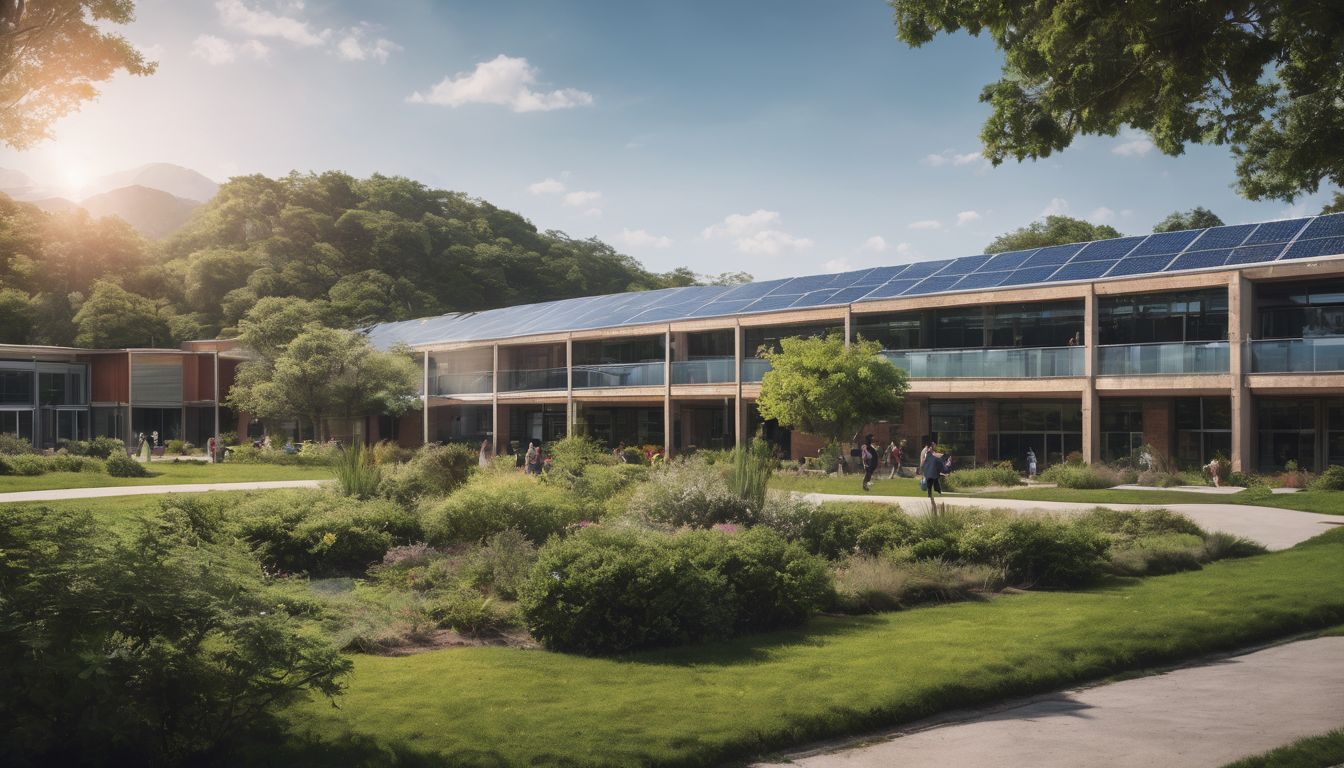Are you interested in environmental sustainability and sports?
Sustainable practices in sports can help reduce the negative impact on the environment.
In this article, we will explore how sustainable practices in sports and physical education can benefit our planet and our health.
Join us as we discover ways to promote eco-friendly initiatives in athletics and fitness.
Key Takeaways
- Engaging in outdoor education and nature – based activities enhances understanding of environmental issues and encourages sustainable practices among young athletes and students.
- The ISO20121 Certification is pivotal for driving sustainability in sport events, providing a structured approach to planning that reduces environmental impact and promotes community involvement.
- Collaborative efforts with local communities, businesses, and government agencies are essential for integrating sustainable development into sports events and physical education programs.
Importance of environmental sustainability in sports and physical education
Environmental sustainability in sports and physical education is critical for the health of our planet. Whether it’s reducing carbon footprints by using sustainable modes of transportation to get to events or integrating eco-friendly practices into athletic training, every action counts.
Sustainable development within these fields ensures longterm provision for future generations, promoting a healthy lifestyle that respects the earth.
School-based programs and community sports initiatives have a unique opportunity to inspire positive change. By incorporating sustainability into the physical education curriculum, educators can embed deeper environmental values in students.
Sustainable athletic facilities not only minimise ecological impact but also set a standard for how communities engage with ecoconscious exercise. Encouraging green initiatives helps create a culture where both fitness and conservation go hand in hand.
Growing interest in sustainable practices
More and more people now recognise the critical role that sustainable practices play in sports and physical education. They understand that to protect our planet, we must integrate environmental conservation into every aspect of our lives, including the way we exercise and play sports.
Athletes, coaches, and event organisers are increasingly adopting eco-friendly practices to reduce their carbon footprint.
Schools are embedding sustainability values into their curricula, showing young students how important it is to care for the environment through outdoor activities. In athletic training programs across the globe, there’s a push towards using renewable energy sources and promoting quality of life with a smaller environmental impact.
This shift isn’t just about playing green— it’s about fostering a culture of sustainability within communities that value health, wellbeing, and stewardship of nature.
The Role of Nature-Based Adventure Tourism in Promoting Sustainability
Examine the case study in Norway and discover the benefits of nature-based tourism, including encouraging eco-friendly practices. Read on to explore how nature-based adventure tourism can play a vital role in promoting sustainability in sports and physical education.
Case study in Norway
Norway presents a compelling case study in promoting sustainability through nature-based adventure tourism. The country’s stunning natural landscapes and fjords have become the backdrop for eco-friendly activities such as hiking, skiing, and wildlife watching.
By embracing sustainable practices, Norway has successfully attracted environmentally conscious travelers while preserving its pristine environment. This approach aligns with the growing interest in incorporating environmental conservation into sports and physical education programs, offering valuable insights into the benefits of integrating sustainable initiatives.
The Norwegian model demonstrates how nature-based adventure tourism can not only contribute to local economies but also serve as a platform for promoting environmental awareness and conservation efforts.
Benefits of nature-based tourism
Nature-based tourism offers numerous benefits to environmental conservation and sustainable practices in sports and physical education. Here are the advantages:
- Encourages appreciation for natural environments and wildlife, fostering a sense of environmental responsibility among participants.
- Promotes physical activity in scenic natural settings, contributing to improved physical fitness and mental well-being.
- Provides opportunities for educational experiences that raise awareness about ecological systems and the importance of preserving natural habitats.
Encouraging eco-friendly practices
Encouraging eco-friendly practices in sports and physical education is crucial for minimising environmental impact. Incorporating sustainable principles can be achieved by:
- Implementing recycling initiatives to reduce waste and promote conservation efforts.
- Utilising renewable energy sources such as solar or wind power for athletic facilities and events, reducing carbon footprint.
- Promoting the use of eco – friendly equipment and materials during sports activities to minimise environmental harm.
- Introducing educational programmes on environmental conservation within physical education curriculum, fostering sustainability awareness.
- Incorporating nature-based activities, such as outdoor field trips or nature-themed games, to inspire a deeper connection with the environment.
- Collaborating with local communities and stakeholders to organise green sporting events that prioritise sustainable practices.
- Advocating for the adoption of environmentally conscious policies and guidelines in sports organisations to drive long-term change.
Integration of Sustainability in Local Sport Event Policies
Examining puzzle approaches to promoting sustainable event planning and involving stakeholders.
Examining puzzle approaches
Puzzle approaches in promoting sustainability within local sport event policies involve strategic problem-solving. Addressing the complexities of sustainable event planning requires innovative thinking and collaboration.
Stakeholders play a pivotal role in integrating eco-friendly practices into sports events, emphasising the importance of inclusive decision-making.
Considering different perspectives is crucial when examining puzzle approaches for sustainable event planning. Encouraging diverse stakeholder involvement fosters a holistic approach to embedding environmental conservation in sports and physical education programmes, creating a more comprehensive framework for sustainable development.
Promoting sustainable event planning
After examining puzzle approaches, promoting sustainable event planning involves implementing eco-friendly strategies to minimise the environmental impact of sporting events. This can be achieved through:
- Utilising renewable energy sources, such as solar or wind power, to reduce carbon footprint and promote green initiatives in sports and fitness.
- Implementing waste reduction measures by encouraging recycling, composting, and limiting single-use plastics at sporting events.
- Incorporating sustainable transport options for attendees and participants, such as promoting public transportation, cycling, or carpooling to reduce emissions.
- Partnering with local businesses and suppliers that adhere to sustainable practices for event catering and merchandise, supporting conservation efforts.
- Promoting water conservation by using efficient water management techniques and reducing overall water usage during events.
- Engaging with local communities to raise awareness and garner support for sustainable event planning, fostering a culture of environmental responsibility in athletic programmes.
- Monitoring and evaluating the environmental impact of sporting events through data collection and analysis to continually improve sustainability practices in sports and physical education.
Involvement of stakeholders
- Collaborating with local communities to organise sustainable sports events, reducing the environmental impact.
- Encouraging the integration of environmental education into school-based sports programmes, fostering a culture of sustainability among young athletes.
- Supporting initiatives for renewable energy use in athletic facilities, contributing to carbon footprint reduction.
- Engaging in advocacy for the implementation of green sports movement, promoting eco-friendly practices in athletic training and fitness programmes.
- Participating in the design and execution of sustainable development projects within sports and fitness organisations, ensuring long-term conservation efforts.
The Connection Between Experiences with Nature and Sustainable Learning
Exploring the cause-and-effect relationship between experiences with nature and sustainable learning, this section highlights the importance of outdoor education in promoting environmental sustainability within sports and physical education.
It delves into the evidence supporting the connection and emphasises the significance of integrating nature-based experiences into educational practices.
Evidence of cause-and-effect relationship
Engaging with nature positively impacts sustainable learning. Research demonstrates that outdoor education enhances environmental awareness and encourages pro-environmental behaviors among students.
Students who participate in outdoor activities develop a deeper connection with nature, leading to a greater appreciation for the environment. This cause-and-effect relationship highlights the importance of integrating outdoor education into school-based sports and physical education programs.
Integrating sustainability into physical education not only benefits students but also contributes to a culture of environmental consciousness within athletic programs. By encouraging eco-friendly practices and incorporating sustainability into the curriculum, schools can foster an ethos of respect for the environment among students.
Importance of outdoor education
Outdoor education plays a crucial role in promoting environmental sustainability and fostering a deeper connection with nature. Engaging students in outdoor activities, such as hiking, camping, and hands-on experiences in natural environments, provides them with firsthand knowledge of the importance of preserving natural resources.
This immersive approach encourages eco-friendly practices and instills a sense of responsibility towards the environment from an early age. Incorporating outdoor education into physical activity programs helps nurture future generations who are mindful of their impact on the planet.
Moving forward to “The Role of Nature-Based Adventure Tourism in Promoting Sustainability,” let’s explore how sustainable practices can be integrated into tourism activities for positive environmental impact.
The Influence of ISO20121 Certification on Sustainable Sport Events
The ISO20121 Certification plays a crucial role in ensuring sustainable practices in sport events, providing a conceptual typology for event planning and emphasising the importance of environmental management.
It brings challenges and benefits to event organisers, serving as a gamechanger in promoting eco-friendly initiatives within the sports industry.
Conceptual typology
The ISO20121 certification establishes a conceptual typology for sustainable sport events, encompassing a comprehensive framework to guide event organisers in integrating environmental and social responsibility into their operations.
This typology categorises different aspects of sustainability within sport events, such as waste management, energy consumption, and community engagement. As the certification sets clear benchmarks and guidelines for sustainable practices, it serves as a roadmap for event planners seeking to align with eco-friendly initiatives.
Embracing this conceptual typology fosters a proactive approach towards mitigating the environmental impact of sports events while enhancing community involvement and promoting green initiatives.
Implementing the ISO20121 conceptual typology involves meticulous planning and coordination amongst stakeholders to ensure successful integration of sustainable strategies in sports events.
Event organisers must navigate potential detours by anticipating challenges related to resource management, stakeholder collaboration, and adapting existing infrastructure to meet sustainability goals.
Potential detours and gamechangers
ISO20121 Certification can be a significant gamechanger in promoting sustainable sport events. It provides a structured framework for assessing environmental impact and implementing eco-friendly practices.
With increasing focus on sustainability, the certification offers a detour from traditional event planning, paving the way for long-term environmental conservation and renewable energy integration within sports and physical education.
Implementing ISO20121 Certification requires dedicated efforts and resources but presents an opportunity to lead the way in sustainable development within the sports sector. Embracing this change can set new standards for environmentally friendly practices that positively influence athletic training, local sport events, and physical education curriculum while contributing to global conservation efforts.
Challenges and benefits of certification
- Certification Challenges:
- Initial cost of obtaining ISO20121 certification can be a barrier for smaller sporting events
- The rigorous documentation and compliance requirements may pose challenges for event organisers
- Difficulty in aligning existing event practices with the standards set by ISO20121
- Environmental Impact:
- Certification drives a reduction in carbon emissions through mandatory monitoring and management processes
- It encourages the use of renewable energy sources during sports events, contributing to overall sustainability efforts
- Implementing ISO20121 standards leads to better waste management practices, reducing environmental impact
- Improved Brand Reputation:
- Certification enhances the reputation of sport events, attracting environmentally conscious spectators and sponsors
- Adhering to sustainable practices can strengthen partnerships with eco – friendly businesses and organisations
- ISO20121 certification provides a competitive edge by demonstrating commitment to environmental responsibility
- Long-Term Sustainability:
- The structured approach under ISO20121 fosters continuous improvement in sustainable event planning over time
- Embracing certification principles encourages long – term behaviour change towards sustainability within the sports industry
- Establishing a culture of green initiatives leads to lasting positive impacts on environmental conservation.
Ways to Promote Sustainable Development in Physical Education
Introducing sustainable values into the physical education curriculum, collaborating with stakeholders, and using an intervention mapping approach can all promote sustainable development in physical education.
To learn more about these strategies and their impact on environmental sustainability in sports and fitness, read the full blog post!
Use of intervention mapping approach
The intervention mapping approach is effective in promoting sustainable development in physical education.
- Identifying determinants of sustainable behaviours: This involves understanding the factors that influence environmentally friendly practices in sports and physical education, such as attitudes, beliefs, and social norms.
- Designing targeted interventions: Utilising the data from determinants analysis to develop specific strategies that encourage eco-friendly practices amongst students and athletes.
- Implementing tailored programmes: Creating interventions based on the identified determinants to foster a culture of sustainability within school-based sports and fitness programmes.
- Evaluating impact: Conducting regular assessments to measure the effectiveness of the interventions and make necessary adjustments for continuous improvement.
- Collaboration with stakeholders: Engaging with educators, sports coaches, and environmental conservation experts to ensure the intervention aligns with best practices and current sustainability trends.
- Embedding sustainable values in curriculum: Integrating environmental sustainability topics into physical education classes and athletic training sessions to promote long-term behavioural change among students and athletes.
- Promoting green initiatives: Encouraging the adoption of renewable energy sources, waste reduction efforts, and responsible resource management within sports facilities and training grounds.
- Creating a culture of sustainability: Establishing an environment where eco-friendly practices are not just encouraged but deeply rooted in the ethos of sports and fitness programmes.
Collaboration with stakeholders
- Involving local community groups, schools, and environmental organisations in the planning and execution of eco-friendly sports events to ensure diverse perspectives and expertise.
- Partnering with renewable energy companies, aiming for energy-efficient facilities, and exploring sustainable transport options for athletes and spectators to reduce environmental impact.
- Engaging with local businesses to source eco – friendly sports equipment and supplies, promoting waste reduction and recycling initiatives within athletic programmes.
- Coordinating with government agencies to integrate sustainability principles into the physical education curriculum, aligning with national conservation efforts.
- Collaborating with sports associations to establish guidelines for implementing sustainable practices in athletic training programmes, emphasising safe and environmentally friendly techniques.
Embedding sustainable values in curriculum
The integration of sustainable values in the physical education curriculum fosters environmental awareness and responsibility among students. Promoting eco-friendly practices, renewable energy, and the importance of minimising the environmental impact in sports activities are key components of embedding sustainable values into educational programmes.
Encouraging green initiatives in sports and fitness not only promotes sustainability but also instils a culture that supports conservation efforts. By incorporating these principles into the curriculum, schools can play a vital role in creating a generation of environmentally conscious individuals who understand the significance of integrating sustainability into sports and physical education.
Incorporating sustainability into physical education curriculum is essential for promoting environmental consciousness among students. Implementing sustainable strategies such as nature-based adventure tourism, eco-friendly practices, and renewable energy usage can significantly contribute to developing an environmentally responsible mindset among students partaking in athletic programmes.
Conclusion
In summary, sustainable practices in sports and physical education are essential for promoting environmental conservation. Integrating sustainability into sports and physical activity fosters a culture of eco-friendly practices.
Implementing renewable energy sources and collaborative strategies with stakeholders contributes to creating a greener future for athletic programs. Encouraging environmentally conscious individuals to support sustainable development in sports and fitness can lead to a significant impact on the environment.
FAQs
1. What are sustainable practices in sports and physical education?
Sustainable practices in sports include using eco-friendly equipment, promoting environmental sustainability, and integrating sustainability into both school-based programmes and the physical education curriculum.
2. How can schools incorporate sustainability into their physical education programmes?
Schools can incorporate sustainability by educating students on eco-friendly sports practices, installing renewable energy sources for sporting facilities, and creating a culture of sustainability within athletic programmes.
3. Why is it important to implement sustainable strategies in sports and physical activity?
Implementing sustainable strategies is vital to ensure that sports contribute to sustainable development whilst minimising environmental impact during fitness activities.
4. Can the use of renewable energy be applied in sports?
Yes, utilising renewable energy sources plays a significant role in advancing eco-friendly practices within various aspects of sports, including stadiums and training facilities for physical education.





